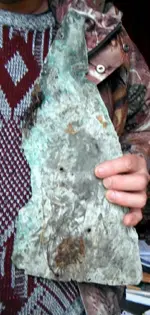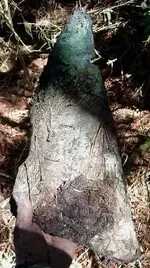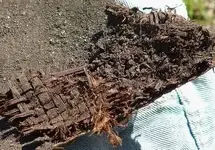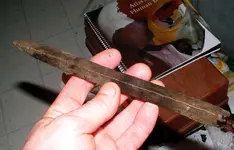...tell why would they have woven cedar bark covering the copper. it just seams odd to me.
This bark is woven and attached to the copper, they are part of the same arifact and Coincidentally ,

it is the same style of bark weaving that the fn used to make cloths.

I guess there is no way this guy, would think to punch in holes in his copper breast plate and weave the bark around it, it would be more, as Spock would say, its only logical to just hold the copper breast plate in front of him.
 Home - American Indians of the Pacific Northwest - LCC Research Guides at Lane Community College
View attachment 725184
Home - American Indians of the Pacific Northwest - LCC Research Guides at Lane Community College
View attachment 725184
woven cedar bark is not what the white man used to cover the cooper sheathing used on ships,

but then you clearly are the expert of ships and fn artifacts made form copper and cedar bark , so who am i to argue.
i Will say , I am in the process of having a expert identifying it.
Hey hmmm,
Did you take measurements and weigh this copper? Is it copper sheet? Does it show signs of being worked / hammered? What about those holes? Could you get all macro, photographically speaking, please?
I don't think it was "body armor," from what I have read of the northern coastal tribes. The woven cedar bark seems like a larger weave, than that used for cloth. More like the weave used in burden baskets, to my eyes.
~~~ I had computer issues last night. This is the 3rd response I've tried to post, concerning your great find.~~~
Let me posit a theory; long ago there was a beach comber / clam digger, who had combed the beach, and turned up less than a satisfactory haul of mollusks, she turned back to the water's edge and spied something...
It had the verdigris patina of weathered... COPPER! She approached slowly, cautiously. Was it? How did it? She looked around quickly, picked it up, and hurriedly placed it in her basket. She ran for the tree line, so she could examine it further. It surely looked like copper. She was scared. She couldn't have this copper. It was too valuable. The stuff of Chiefs.
She quickly buried it in her basket, and ran to seek the counsel of her husband...
"This very large Haida copper shield (117 cm. high) once belonged to Albert Edward Edenshaw. He was a talented shield engraver and sold his decorated coppers as far south as the Fraser River. This copper portrays his female Grizzly Bear crest. Purchased from Mary Yaltatse of Masset in 1970. CMC VII-B-1595
Copper was the ultimate symbol of wealth among the native peoples of the Northwest Coast; like gold, it reflects the brilliance of the sun. According to Nuxalk legend, copper was given to the people by Tsonoqua, who received it from Qomoqua, the master of wealth who lives in a copper house at the bottom of the sea. According to Haida tradition, copper came from the territory of the Eyak people in the Copper River area of Alaska, where it occurs as pure nuggets in the river gravels. In the Prince Rupert harbour shell middens, the use of copper in the form of bracelets, pendants and tubes can be traced back more than 2,000 years, and thus appears to be an early feature of north coast trading and warfare.
Throughout the coast, shields made of copper denoted the high rank of their owners and were exchanged at ever higher values between chiefs at potlatch feasts. Among the Kwakwaka'wakw, coppers were particularly associated with the distribution of wealth at weddings. The Haida used coppers as a marker and symbol of wealth, and some wealthy chiefs owned a dozen or more. A copper which belonged to Albert Edward Edenshaw was sold to a Tsimshian chief for eight slaves, one large cedar canoe, one hundred elkskins and eighty boxes of eulachon grease. After a chief's death, his coppers were often fastened on his memorial pole."
Civilization.ca - Treasures Gallery - Coppers HI ALL
HI ALL













